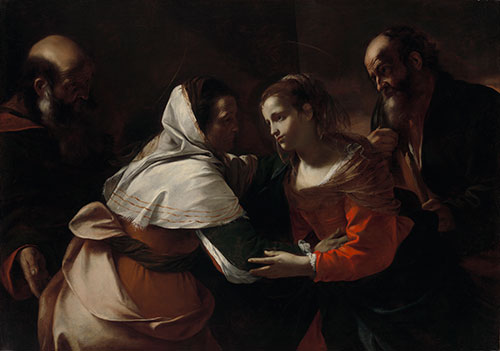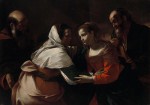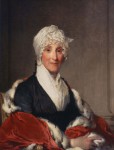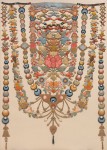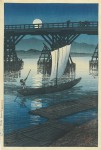Two important paintings, one by 17th-century Italian painter Mattia Preti and the other by 19th-century American portraitist Gilbert Stuart, have been acquired by the Virginia Museum of Fine Arts and are on view in the galleries in time for the holidays.
17th-century Italian painting
Mattia Preti (Italian, 1613–1619), The Visitation, oil on canvas, 47 5/16”H × 67 1/32”W. Virginia Museum of Fine Arts, Richmond. Arthur and Margaret Glasgow Endowment.
The Visitation is an exceptional religious scene by the Baroque master Mattia Preti, whose work illustrates the realistic tendencies perfected by fellow Italian artist, Caravaggio (Michelangelo Merisi). Preti is generally described as the last great exponent of Caravaggesque naturalism, and here he revels in the tenderness of the scene unlike the coarse treatments of some of his counterparts. Especially appropriate to the Christmas season, this painting depicts the meeting of the Virgin Mary and her cousin Elizabeth, the first episode in the life of Christ recorded by Luke.
Preti, although born in Calabria and active in Naples and Malta later in his career, was working in Rome at the time this painting was produced. The museum’s holdings include important works by great artists active in Naples including Luca Giordano, Paolo de Matteis, Francesco Solimena, Salvator Rosa, and Artemisia Gentileschi. The addition of this work further enhances VMFA’s collection as a destination for the study of the Neapolitan baroque.
In this powerful and dramatic painting, Preti represents the meeting of the Virgin Mary with her older cousin Elizabeth. Mary hastened to visit her kinswoman following the Annunciation by the Angel Gabriel. Elizabeth, who was soon to give birth to St. John the Baptist, recognizes that Mary has been chosen as the mother of the Son of God, and greets her with the words “Blessed art thou among women and blessed is the fruit of thy womb. . . . For lo, as soon as the voice of thy salvation sounded in mine ears, the babe leaped in my womb for joy.” (Luke 1:42-44)
“This old master painting will become a visitor favorite, as well as a touchstone for the artist,” Director Alex Nyerges said. “We can think of no better Christmas gift to the commonwealth than exquisite art for all to enjoy.”
19th-century American portrait
Gilbert Stuart (American, 1755-1828), Portrait of Rebecca White Pickering (Mrs. Timothy Pickering), 1817-18, oil on wood. J. Harwood and Louise B. Cochrane Fund for American Art.
Gilbert Stuart – “the Vandyke of the Time”– was a master portraitist whose talents coincided with the needs of a generation anxiously crafting a new American identity. After the Revolution, persons once subject to the hierarchical social structure of the British Empire were freed to negotiate public and private selves within the context of a self-determined republic. To this end, Stuart imbued his clients’ portraits with the social parity accorded an international society of merchants, landowners and aristocrats. With its dazzling display of luxurious textures, this stunning likeness of the Massachusetts matriarch, Rebecca White Pickering (1754-1828), numbers among his finest work.
“Celebrated by his contemporaries for his life portraits of George Washington,” Susan Jensen Rawles, interim department head of American art said, “Stuart’s extraordinary talents are rarely as evident as in this portrait of Rebecca Pickering, its rich tones rendered with a fluid touch. We are thrilled to add it our American collections.”
84 Japanese works
Also acquired are 84 works by the 20th century Japanese shin-hanga woodblock print master, Kawase Hasui. In addition to this gift, collectors René and Carolyn Balcer have donated more than 580 Hasui works to VMFA. The exhibition, Water and Shadow: Kawase Hasui and Japanese Landscape Prints, is on view in VMFA’s Evans Court Gallery.
Born in Tokyo, Kawase Hasui was trained in traditional Japanese painting, watercolor, and oil painting. He studied Japanese prints with Kaburaki Kiyokata (1878-1972), and then began to work as an illustrator for magazines and advertisements. In 1918, Hasui’s first experimental prints were published by Watanabe Shōzaburō (1885-1962), initiating a collaboration that would last for the rest of Hasui’s life. The prints created by Hasui were named as “new prints” (shin-hanga), an art movement that began in the early 20th century. By bringing together the talents of an artist, a block carver, a printer, and a publisher, shin-hanga works mimicked the traditional collaborative process of ukiyo-e printmaking, as opposed to the “creative prints” (sosaku-hanga), another movement that emerged in Japan at the same time and advocated artists to create prints through their individual effort.
Tibetan textile
Tibetan, Temple Hanging, dyed and painted silk appliqué, 93½”H × 67⅛”W. Virginia Museum of Fine Arts, Richmond. Gift of Anne and Larry Heilman.
VMFA’s world-class Himalayan collection is enriched by the gift of a large and visually powerful Tibetan textile. Nearly eight feet tall, it is composed of hundreds of small, quilted and embroidered silk elements—most auspicious emblems—joined to form an elaborate garland centered on an unfolding lotus. This colorful hanging would once have enlivened the interior of a Buddhist temple, where it might have either fronted a large altar or hung above an entryway, rather like an ornamental festoon in western architecture. Donors Anne and Larry Heilman of Chevy Chase, Md., acquired the textile in Kathmandu, Nepal in 1972.
Additional Acquisitions
American
• Edward Heim (American, before 1880 – after 1937), Bessie Potter Vonnoh, ca. 1927, photograph, 9½ x 7¼”. Gift of Alexander Reeves, Richmond
Decorative Arts
• Jean Lurcat (French, 1892-1966): three Aubusson tapestries from 1965, wool:
Gemini, woven by the Atelier Gisèle Brivet, 41½ x 58¼”
The Awakening, woven by the Atelier Gisèle Brivet, 48 ⅜ x 79¼”
Cascade, woven by the Atelier Picaud, 42¾ x 58¼”
Gift of Mary and Lucien Rubenstein, Madison, WI
Photography
1. Selection of photographs by Rodchenko and other Russian Constructivists.
• Alexander Rodchenko (Russian, 1891–1956):
° with Henri Manuel (Russian, 1874 – 1947), Alexandr Rodchenko’s Worker’s Club installation at the 1925 Decorative Arts exhibition in Paris, 1925, gelatin silver print, 11.8 x 9.25”
° House on Novinskii Boulevard – Project architect Moisei Ginzburg, 1929, vintage gelatin silver print, 4¾ x 6¼”
° The Worker’s Faculty Student, 1924, vintage gelatin silver print; 4.8 x 3.4”
° Workers’ Demonstration, 1932, toned vintage gelatin silver print , 17.4 x 11.10”
° Fotomontazh k poeme V. Mayakovskovo ‘Pro Eto’ (Photomontage for Mayakovsky’s poem, ‘About This’), 1923, gelatin silver print, 9.4 x 6.8”
° Corner, 1925 (Untitled (Building), 1925), gelatin silver print, 5 x 6.10”
° Dom Mosselproma. House of Mosselprom, decorated by Rodchenko, 1925, gelatin silver print, 9.8 x 6.4”
° Canteen at the Electric Plant, 1929, gelatin silver print, 6.12 x 4.8”
° Pryzhok s shestom (High Jumper), 1937, gelatin silver print, 5.12 x 6.12”
° Pine trees. From the Karelia series, 1933, gelatin silver print; 8.8 x 5.8”
• Gustav Klutsis (1895 – 1938), Delo Chesti, Slavy, Doblesti i Gerojstva! (A Matter of Honor, Glory, Valor and Heroism!), 1931, vintage gelatin silver photomontage
• Max Alpert (1899–1980), Untitled (Dnepr Dam), gelatin silver print; 12.12 x 9”
• Piotr Otsup (1883 – 1963), S. Kobozev na sjemke prazdnovanija pervoj godovshchini Oktriabria. I.S. Kobozev (photographer) photographing the first October Celebration, 1918, gelatin silver print, 6.8 x 4.10”
• Georgi Zelma (Russian, 1906 – 1984):
° Tractor Driver, Birobizhan, mid – 1930s, vintage gelatin silver print; 2.3 x 3.1”
° Krasnaya Ploschad’, Kolonna ‘Elektrozavoda’. Red Square, Column of Electro-Factory, 1931, gelatin silver print, 4.1 x 6.5 in.
Adolph D. and Wilkins C. Williams Fund
2. 12 photographs purchased from the Estate of George Cruger:
• Mary Ellen Mark (American, b. 1941), India, 1989, gelatin sliver print
• Alvin Langdon Coburn, (British,1882–1966), Greyfriars Church, photogravure
• Unknown photographer, (Point Lobos), ca. 1930, silver gelatin print,
• Unknown photographer, Louvre Gallery nearly Empty, 1939, series of five silver-gelatin prints
• Claudio Cambon (American, b. 1967), ‘Papa’ John Wallace, Bosun, 1998, gelatin-silver print
• Unknown photographer (perhaps from New York Herald-Tribune), two gelatin-silver prints depicting José Ramón Miguel Agustín Pro Juárez, 1927, gelatin-silver print
• Underwood & Underwood, Some Men Climb ‘Some Heights’ To Get Some Women, ca. 1930. Kathleen Boone Samuels Memorial Fund
3. Gyorgy Kepes (American/Hungarian, 1906-2001), four untitled abstractions, gelatin silver prints. Adolph D. and Wilkins C. Williams Fund
4. Arnold Newman (American, 1918-2006), four silver gelatin prints:
• Man Ray, Los Angeles, 1948
• Moses & Raphael Soyer, NYC, 1942
• Grandma Moses, Eage Bridge, NY
• Danny Kaye
Kathleen Boone Samuels Memorial Fund
5. Elisabeth Sunday (American, born 1958), Emerge (Tuareg Woman, The Sahara Desert, Mali), 2007, platinum print on rag paper. Adolph D. and Wilkins C. Williams Fund
About VMFA Acquisitions:
These works of art were approved by the VMFA Board of Trustees in December 2014. VMFA is a state agency and a public/private partnership. All art is purchased with private funds from dedicated endowments. After VMFA’s board approves proposed acquisitions the art becomes the property of the Commonwealth of Virginia to protect, preserve, and interpret.
About the Virginia Museum of Fine Arts
VMFA’s permanent collection encompasses more than 33,000 works of art spanning 5,000 years of world history. Its collections of Art Nouveau and Art Deco, English silver, Fabergé, and the art of South Asia are among the finest in the nation. With acclaimed holdings in American, British Sporting, Impressionist and Post-Impressionist, and Modern and Contemporary art – and additional strengths in African, Ancient, East Asian, and European – VMFA ranks as one of the top comprehensive art museums in the United States. Programs include educational activities and studio classes for all ages, plus lively after-hours events. VMFA’s Statewide Partnership program includes traveling exhibitions, artist and teacher workshops, and lectures across the Commonwealth. VMFA, a certified Virginia Green attraction, is open 365 days a year and general admission is always free. For additional information, telephone 804-340-1400 or visit www.vmfa.museum.
# # #
